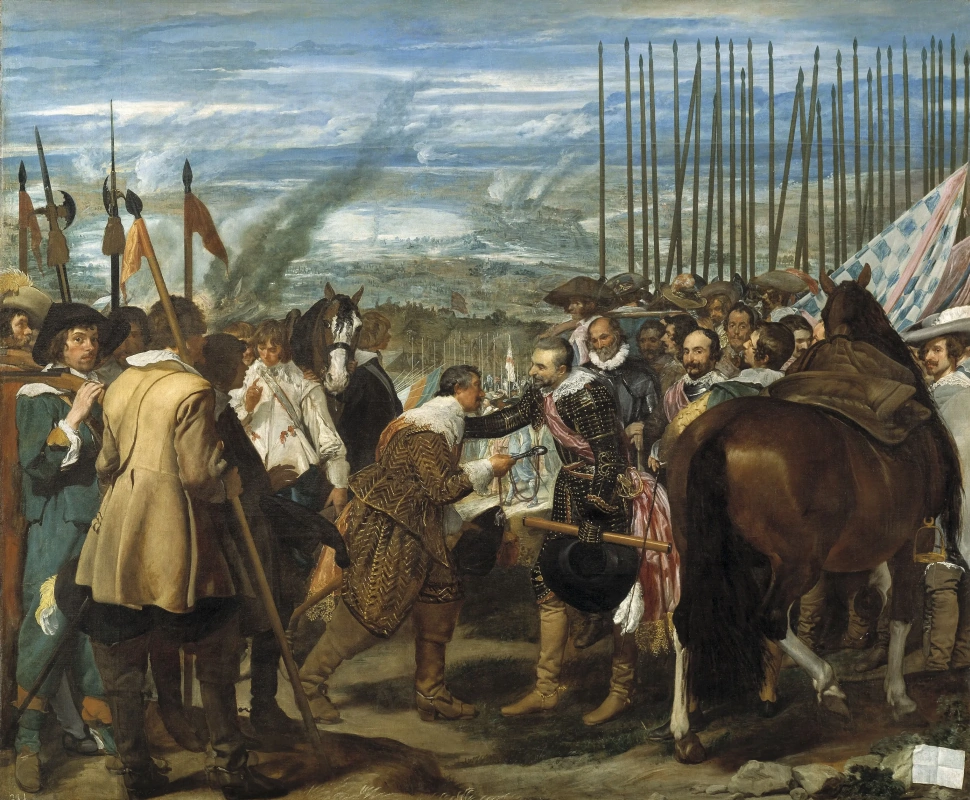log in
Enter site
Login to use Arthive functionality to the maximum
The Surrender of Breda
Diego Velazquez • Painting, 1635, 307×367 cm












Description of the artwork «The Surrender of Breda»
"The Surrender of Breda" by Diego Velazquez is one of the most famous and important works of European historical painting. This large-scale painting (307 x 367 cm) was commissioned especially for the newly built Royal residence of Buen Retiro (unfortunately it was destroyed during the offensive on Madrid by the French in the early 19th century). The name of the Buen Retiro castle is translated from Spanish as "blessed solitude". However, its design, which was done by the king's first Minister, the Duke Gaspar Gusman, count de Olivares (1, 2, 3) was not intimate, but extremely solemn and ceremonial. The Surrender of Breda was one of 20 large paintings, which were supposed to decorate the Hall of the Kingdoms aimed to glorify the military feats and conquests of the Spanish monarch (and the patron of Velazquez) Philip IV.
Breda was the Dutch city, an important strategic point in the war of Spain and the Netherlands. Being predominantly Protestant, the Netherlands sought to defend their independence from Catholic Spain. But Madrid, whose crown in the early seventeenth century united almost half of the territories of the Old and the New worlds, did not want to lose their Northern colonies. In 1625, the heroically resisting Breda was besieged by the Spaniards. The siege have lasted nine months. After all Breda fell under the pressure of the Spaniards.
Velasquez captured the moment when the commandant of the Dutch Fort, Justin of Nassau is handing the key to the Spanish Admiral Ambrosio Spinola, who is respectfully patting an opponent on the shoulder. When portraying the central group, Velasquez refers to Peter Paul Rubens' The meeting of Abraham and Melchizedek.
We observe no confrontation between the bitter rivals and this looks like not a shameful surrender of the city, but perhaps the act of signing the peace pact. Both commanders are full of dignity: Velasquez treats the keys of Breda almost like a meeting between old friends. Only groups of the officers on either side of them show that there are winners and losers. The winning Spanish army is on the left. The Spanish spears look at the sky: their density indicates the number of the Spaniards, and the fact that spears are almost parallel marks their brilliant military discipline. The Dutch on the left, by contrast, appear confused. But the Spaniard Velasquez very carefully refers to the self-esteem of the opponents: he is not showing them either broken or humiliated. By the way, "Surrender of Breda" is also known under the alternative title The Spears, and in the extreme right of the Spanish (with the mustache, the proud look and a hat with a plume), many researchers have seen the artist’s self-portrait.
Neither Justin of Nassau, nor Ambrosio Spinola (whom Velasquez was briefly familiar) could appreciate the magnificent art of Velazquez: by the time of the creation of the painting (about 1635) two of them were already dead. But this painting captured them for history. Now everyone who visits the halls of Madrid's Prado, can look at one of the most objective historical paintings ever. Here, neither side is shown more rightful or less noble than the other, and both the winner and the loser demonstrate the unprecedented mutual respect between enemies.
Written by Anna Vcherashniaya
Breda was the Dutch city, an important strategic point in the war of Spain and the Netherlands. Being predominantly Protestant, the Netherlands sought to defend their independence from Catholic Spain. But Madrid, whose crown in the early seventeenth century united almost half of the territories of the Old and the New worlds, did not want to lose their Northern colonies. In 1625, the heroically resisting Breda was besieged by the Spaniards. The siege have lasted nine months. After all Breda fell under the pressure of the Spaniards.
Velasquez captured the moment when the commandant of the Dutch Fort, Justin of Nassau is handing the key to the Spanish Admiral Ambrosio Spinola, who is respectfully patting an opponent on the shoulder. When portraying the central group, Velasquez refers to Peter Paul Rubens' The meeting of Abraham and Melchizedek.
We observe no confrontation between the bitter rivals and this looks like not a shameful surrender of the city, but perhaps the act of signing the peace pact. Both commanders are full of dignity: Velasquez treats the keys of Breda almost like a meeting between old friends. Only groups of the officers on either side of them show that there are winners and losers. The winning Spanish army is on the left. The Spanish spears look at the sky: their density indicates the number of the Spaniards, and the fact that spears are almost parallel marks their brilliant military discipline. The Dutch on the left, by contrast, appear confused. But the Spaniard Velasquez very carefully refers to the self-esteem of the opponents: he is not showing them either broken or humiliated. By the way, "Surrender of Breda" is also known under the alternative title The Spears, and in the extreme right of the Spanish (with the mustache, the proud look and a hat with a plume), many researchers have seen the artist’s self-portrait.
Neither Justin of Nassau, nor Ambrosio Spinola (whom Velasquez was briefly familiar) could appreciate the magnificent art of Velazquez: by the time of the creation of the painting (about 1635) two of them were already dead. But this painting captured them for history. Now everyone who visits the halls of Madrid's Prado, can look at one of the most objective historical paintings ever. Here, neither side is shown more rightful or less noble than the other, and both the winner and the loser demonstrate the unprecedented mutual respect between enemies.
Written by Anna Vcherashniaya


